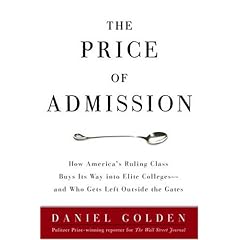 You would be right if you think you see a silver spoon on the cover of this book. It has been out about a year now. It is The Price of Admission: How America's Ruling Class Buys Its Way into Elite Colleges -- and Who Gets Left Outside the Gates, by Daniel Golden.
You would be right if you think you see a silver spoon on the cover of this book. It has been out about a year now. It is The Price of Admission: How America's Ruling Class Buys Its Way into Elite Colleges -- and Who Gets Left Outside the Gates, by Daniel Golden. This is part of a review for the Washington Post's Book World by Jerome Karabel :
"That virtually all elite private colleges give preference to the sons and daughters of alumni will come as a surprise to no one. But preference also extends to wealthy applicants whose families have been identified as potential donors -- "development cases" in the parlance of the trade. Golden documents that even Harvard, with its $25.9 billion endowment, is not above giving preference to the scions of the super-rich. His primary example, however, of development cases being central to the admissions process is Duke, where the university embarked on a systematic strategy of raising its endowment by seeking out wealthy applicants. Golden estimates that Duke admitted 100 development applicants each year in the late 1990s who otherwise would have been rejected. Though this may be something of an extreme case, special consideration for applicants flagged by the development office is standard practice at elite colleges and universities.
Also enjoying substantial preference at elite colleges, both public and private, are varsity athletes. In a fascinating case study of women's sports at the University of Virginia, Golden shows how the effort to comply with Title IX, a gender equity law that has the praiseworthy goal of ensuring equality between female and male athletes, has had the unintended effect of giving an admissions edge to female athletes who play upper-class sports. Between 1992 and 2002, the number of college women nationwide in rowing, a sport highly concentrated in private schools and affluent suburbs, rose from 1,555 to 6,690; more recently, the number of female varsity horseback riders increased from 633 to 1,175 between 1998 and 2002. The net effect of the rise of these overwhelmingly patrician sports, Golden argues, has been to further advantage already advantaged women.
A recent study by the Century Foundation estimated that only 3 percent of freshmen at highly selective colleges came from the bottom socioeconomic quartile, compared to 74 percent from the top quartile. Growing awareness of this shocking disparity has led a number of leading private colleges and universities, including Amherst, Harvard and Princeton, to take measures to increase the number of low-income students. But Golden is surprisingly ambivalent about these efforts, fearing (perhaps justifiably) that the admission of more poor and working-class students will be accompanied not by a reduction of preference for the rich, but by a decline in the number of middle-class students. The Caltech model that he finds so appealing is utterly inadequate to address the problem. Given the magnitude of class disparities in educational achievement, only affirmative action for the disadvantaged -- what former Princeton president William Bowen has called a "thumb on the scale" for low-income students -- promises to produce significant results.The Price of Admission estimates that the end of affirmative action for the privileged would open up roughly 25 percent of the places in the freshman class at elite colleges and, in so doing, free up spaces for aspiring students of modest origins. Based on my own research, I would estimate a figure of 10 to 15 percent -- still a considerable number. But the main beneficiaries of such a shift -- absent a more profound change in the prevailing definition of merit -- would not be the socioeconomically disadvantaged, but rather the children of the upper-middle class."
1 comment:
It seems to me they are gonna continue this practice whether we like it or not. So I have an idea. Require the wealthy students who aren't deserving to be admitted to pay for a low-income student. So for every rich undeserving student, you have a deserving low-income student. Actually, if they are that wealthy I would prefer to see it be more like they pay for 3 low income students. An easy way to do this would be set up a scholarship fund they must donate to before they are admitted. I'm not crazy about the means (the rich getting in because they are rich) but at least the ends seem better.
Post a Comment